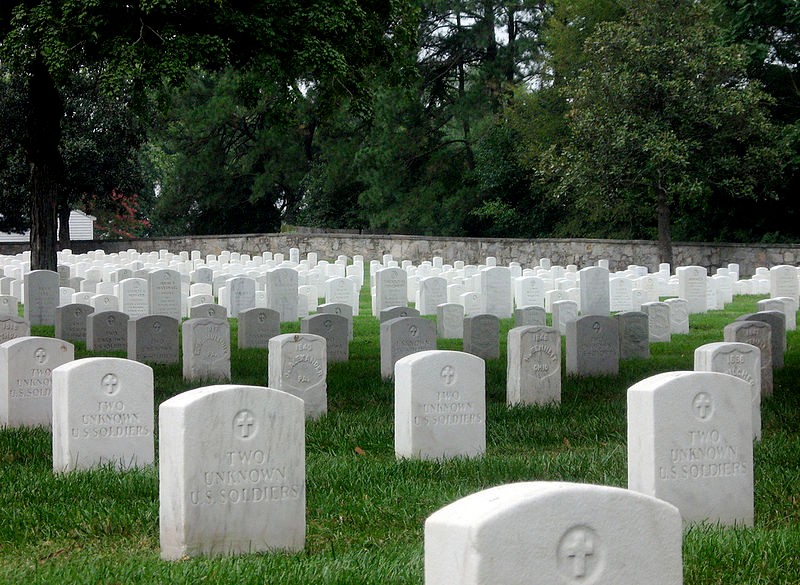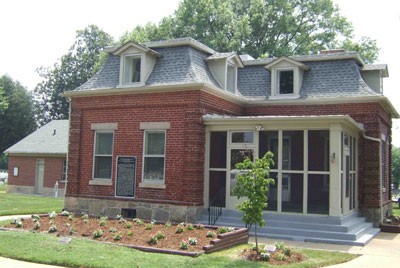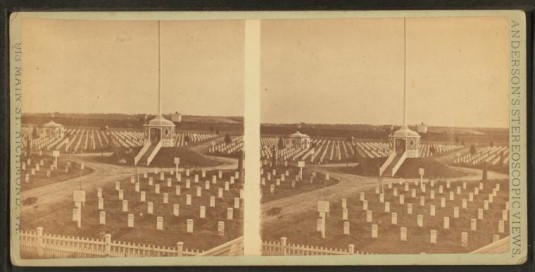Richmond National Cemetery
Introduction
Text-to-speech Audio
Established in 1866, Richmond National Cemetery was opened barely a year after the end of the Civil War and it lies within the former fortification lines built by the Confederate Army. As wartime had flooded Richmond’s earlier cemeteries with corpses, the first burials on this site were re-internments from Oakwood Cemetery and Hollywood Cemetery. Richmond National Cemetery is a reminder of the brutalities that war inflicted on the city and its inhabitants. The cemetery was established by the U.S. Congress through legislation in 1866. The cemetery is on the National Register of Historic Places since 1995.
Images
Richmond National Cemetery

One of the more peculiar headstones. A tree grew around this headstone.

Superintendent's Lodge at the cemetery


Late 1800s-early 1900s image of the cemetery

Backstory and Context
Text-to-speech Audio
The cemetery sits upon the Confederate lines of defense when they fought the Union in Richmond during the Civil War. After the Union victory in 1865, the Confederacy fell apart and slavery was officially abolished due to ratification of the 13th Amendment. The United States Congress wanted to memorialize those who had fallen in the Richmond conflict so they designated some land to become the Richmond National Cemetery. In 1866, they passed legislation establishing the new location, but didn’t acquire the land until 1867 from local owner William Slater. With additional purchases of land in both 1868 and 1906, the cemetery could expand.
Most of those who were first buried in this graveyard hadn’t perished in combat. They were actually prisoners of war that were captured. In particular, they were Union soldiers who had passed away as a direct result of injuries suffered in battle. Many such soldiers spent time trying to recover in Richmond’s wartime hospitals. Even after the end of the war, the amount of casualties was higher than expected so the need for more burial space soon arose which justified the additional land purchases.
Two cemeteries, Oakwood and Hollywood, were bombarded with corpses of fallen soldiers so there were re-internments for those bodies in the Richmond National Cemetery. Soon after, those buried in the Belle Island Prison Camp cemetery were re-interred here as well. Later on, as local cemeteries such as Seven Pines National Cemetery and Cold Harbor National Cemetery were reaching their maximum capacities, many bodies were redirected towards Richmond. The high volume of bodies made it apparent the need for more space and only two years after Richmond National Cemetery was established, more land was purchased to expand the site. The cemetery is now 9.7 acres large.
Although many veterans are buried here, Richmond National Cemetery no longer accepts new interments. Spaces may become available either due to cancelled reservations or when disinterments are completed. In 1995, it was added to the National Register of Historic Places. Overflowing with corpses from numerous wars, Richmond National Cemetery is even nowadays a reminder of the terrible consequences of war. It all started after the American Civil War.
Sources
“Richmond National Cemetery, Richmond Virginia," National Park Service. Accessed June 4, 2016.
https://www.nps.gov/nr/travel/national_cemeteries/Virginia/Richmond_National_Cemetery.html
“Richmond National Cemetery,” National Cemetery Administration. Accessed July 14th 2021. https://www.cem.va.gov/cems/nchp/richmond.asp
